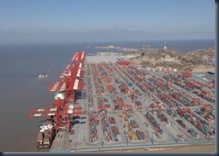 April 16, 2010
April 16, 2010
by NPR Staff and Wires
Tibetan monks prayed over hundreds of bodies Friday at a makeshift morgue next to their monastery after powerful earthquakes destroyed the remote mountain town of Jiegu in western China and left at least 791 people dead.
The official toll was likely to climb further. Gerlai Tenzing, a red-robed monk from the Jiegu Monastery, estimated that about 1,000 bodies had been brought to a hillside clearing in the shadow of the monastery. He said a precise count was difficult because bodies continued to trickle in and some had already been taken away by family members.

Alyson Hurt/NPR
As he spoke, three monks and two other men awkwardly loaded two cloth-wrapped corpses into the trunk of a taxi. Nearby, other monks took pictures of bodies and rewrapped them, pinning numbers to each. Others recited prayers as yak-butter candles flickered nearby.
Relief workers estimate that 70 percent to 90 percent of the town of wood-and-mud houses collapsed when the earthquakes hit Yushu county Wednesday morning.
NPR's Anthony Kuhn reported from one of the hardest-hit towns that rescue workers were desperately trying to dig out survivors from the ruins of a collapsed hotel.
"They went at the crumbled hotel first with an excavator, then with shovels, then with hands. Some people were pulled out -- some dead, some alive," Kuhn said.
China Central Television reported that a 13-year-old Tibetan girl was pulled from the toppled two-story Minzhu Hotel on Friday after a sniffer dog alerted rescuers to her location. The girl, identified as Changli Maomu, was freed after a crane lifted a large concrete block out of the rubble, it said. Her condition was good and she was taken to a medical station for treatment, it said.
The official Xinhua News Agency reported Friday afternoon the confirmed death toll had risen to 791, with 294 missing. The report said 11,477 people were injured, 1,174 severely. The strongest of the quakes Wednesday was measured at magnitude 6.9 by the U.S. Geological Survey and 7.1 by China's earthquake administration.
Kuhn said that because the area affected by the quake is relatively small, workers have been able to get heavy machinery, troops and rescue teams in place fairly quickly. But he said altitude in the remote mountain region was making search and rescue efforts more difficult.
"This town is almost 2 miles above sea level and so the oxygen is considerably thinner," he said.
Kuhn also noted that the large population of ethnic Tibetans and the numbers of Tibetan Buddhist monks assisting rescuers adds a politically sensitive edge to the government's aid efforts.
"The government is used to taking the lead and not letting civil society take the lead," Kuhn said. "Another thing they have to watch out for of course is burial practices. The government is burying a lot of the dead who are ethnic Tibetans, and it has to be careful that it doesn't offend them by not respecting their practices.”
To underline official concern for a Tibetan area that saw anti-government protests two years ago, Premier Wen Jiabao arrived in Yushu county Thursday evening to meet survivors. President Hu Jintao, in Brazil after visiting Washington, canceled scheduled stops in Venezuela and Peru to come home.
Wen, the sympathetic, grandfatherly face of the usually distant Chinese leadership, sought to provide comfort and build trust with the mostly Tibetan victims of the quake.
"The disaster you suffered is our disaster. Your suffering is our suffering. Your loss of loved ones is our loss. We mourn as you do. It breaks our hearts," Wen said in remarks repeatedly broadcast on state TV.
Standing atop a pile of rubble clutching a wireless microphone, Wen also repeated nearly word for word the promise he made during the Sichuan earthquake:
"As long as there's a glimmer of hope, we will spare no effort and never give up."
Many survivors shivered through a second night outdoors as they waited for tents to arrive. Hundreds gathered on a plaza around a 50-foot tall statue of the mythical Tibetan King Gesar, wrapped in blankets taken from shattered homes.
Smoke rose from charcoal stoves dotting the plaza as some families brewed salty black tea, a Tibetan staple, and ate flat bread and fried noodles. Others complained there wasn't enough to eat and asked reporters to help them get food.
People with broken arms or legs cried in pain as medical teams could offer little more than injections. A doctor at the Qinghai provincial hospital, where the severely injured were being flown, said she had no idea how many were being treated because there was no time to count them all.
China Central Television reported that about 40,000 tents would be in place by Saturday, enough to accommodate all survivors. Also on the way was more equipment to help probe for signs of life under the debris, it said. The tools include small cameras and microphones attached to poles that can be snaked into crevices as well as heat and motion sensors.
Rescuers continued to probe the rubble for sounds or movement in a rush to find anyone buried alive more than 48 hours after the quakes hit.
At one collapsed building where people were believed trapped, about 70 civilians, including three dozen Tibetan monks in crimson robes, joined rescue workers.
"One, two, three," the monks chanted as they used wooden beams to try to push away a section of collapsed wall. They later tied ropes to a slab of concrete and dragged it away.
Xinhua quoted a local education official as saying 66 children and 10 teachers had died, mostly in three schools, but more remained missing.
Xu Lai, a spokesman for the Qinghai-based educational group Gesanghua, said the first and third grade classrooms at the Yushu No. 3 Wanquan Elementary School crumbled because they were built with mud, instead of brick and cement. Xu was not sure how many bodies or survivors had been recovered at the school.
Thogong Golma, an employee at the Children's Home of Hope for orphans, said the bodies of eight orphans had been found by Friday but 25 remained missing, including many who attended classes at the No. 3 Wanquan school.
"When we arrived at the No. 3 Wanquan Elementary School, the place had already been cleared, and the bodies had been pulled out and taken away," Thogong Golma said. "Right now, we are only looking around the town, asking everyone on the streets if they saw those missing children."
Thousands of students died during a massive Sichuan quake in 2008 when their poorly built schools collapsed. But unlike in Sichuan -- where schools toppled as other buildings stood -- nearly everything fell over in Yushu.
View article and photos...
 (AP Photo/Xinhua)
(AP Photo/Xinhua)



 More than 100 items from U.S. numismatic enthusiast Howard Bowker's coin collection were presented to the Shanghai Mint Museum on April 16. Some of the items are so rare that experts say they are literally priceless. Shen Cichen/NPR
More than 100 items from U.S. numismatic enthusiast Howard Bowker's coin collection were presented to the Shanghai Mint Museum on April 16. Some of the items are so rare that experts say they are literally priceless. Shen Cichen/NPR The Sun Yat-sen copper dollar, issued in 1932, was China's first national coinage. Shen Cichen/NPR
The Sun Yat-sen copper dollar, issued in 1932, was China's first national coinage. Shen Cichen/NPR Shen Cichen/NPR
Shen Cichen/NPR







 April 16, 2010
April 16, 2010
 Korean War veterans in South Korea
Korean War veterans in South Korea Korean War veterans from Canada
Korean War veterans from Canada



